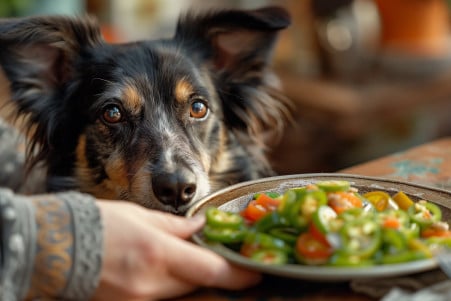Can Dogs Eat Paprika? A Look at Canine Diet and Nutrition
8 February 2024 • Updated 7 February 2024

While paprika is a popular spice in many human recipes, it is not recommended for dogs. This is because paprika can lead to gastrointestinal upset and symptoms like diarrhea and vomiting. It can also cause nasal irritation and other digestive problems. Instead, consider using dog-friendly spices like basil or turmeric.
This article will use information from veterinary medicine, animal nutrition, and toxicology studies to cover the dangers and potential substitutes for giving paprika to dogs, as well as how dogs metabolize spices and nutritional approaches to dog health.
By the end, you will have a better understanding of how to feed your dog in a way that keeps them safe and healthy, and how to make the best choices when it comes to sharing your pantry items with your pet.
Can dogs eat paprika?
Understanding the Dangers: Paprika’s Effect on a Dog’s Digestive System
The most common danger of a dog eating paprika is gastrointestinal upset caused by the spice’s natural irritants. Dogs Journal explains that this can lead to vomiting, diarrhea, and gas, which can then lead to dehydration and general discomfort for your dog. The reason paprika is spicy, which can range from mild to hot, is because of the capsaicin it contains, which is hard for dogs to digest and can lead to digestive upset.
Paprika is also a concern when it comes to allergies. Dogs can be allergic to spices, and if you notice your dog is itching, swelling, or experiencing gastrointestinal distress after eating paprika, it could be a sign of an allergic reaction that you’ll need to keep an eye on.
If you notice your dog is experiencing discomfort after eating paprika, Home Sweet Pups recommends giving them cold water, milk, or yogurt to help soothe any burning they may be experiencing in their mouth and throat.
If you think your dog has eaten a large amount of paprika, call your vet for advice. While a small amount of paprika may not require immediate medical attention, knowing how to handle potential dangers can help ensure your dog’s safety and avoid any issues that may come from their adventurous palate.
How Dogs Metabolize Spices: A Metabolic Perspective
The way dogs digest and metabolize food is very different from humans, especially when it comes to how they metabolize the compounds found in spices like paprika.
Capsaicin, the compound in paprika that makes it spicy, has certain dangers when consumed by dogs. Studies mentioned in PMC have shown that dogs metabolize dietary components differently depending on whether they are on a high-fat or high-starch diet, which suggests that dogs have a unique way of metabolizing capsaicin.
For example, a study in PubMed looked at the impact of capsaicin on dogs with atopic dermatitis and concluded that it needs to be used with caution to avoid exacerbating pruritus, or itchy skin.
While humans can tolerate capsaicin’s heat, a study in PubMed found that when it was introduced intravenously to dogs, it had adverse effects, including transient tachycardia and hypertension. Although these effects were short-lived, they demonstrate how sensitive dogs are to this compound and suggest that oral consumption could lead to similar problems.
Understanding how dogs metabolize capsaicin helps us understand why some spices are not safe for dogs. Dog owners need to understand these metabolic differences so they can make the best choices for their dog’s diet and avoid spices that could be toxic. This information highlights the importance of carefully considering whether to add any spices to a dog’s diet, especially those like paprika that contain capsaicin.
Navigating the Spice Rack: Canine Culinary Caution
While humans often use a wide range of spices to season their food, the same rules can’t be applied to dogs. Dogs metabolize food differently, so something that makes a tasty addition to our meals can be toxic to our furry friends.
For example, onions and garlic can cause anemia in dogs because they contain sulfoxides and disulfides, according to a study published by PMC. Garlic, while less toxic than onions, can still cause Heinz body anemia.
A study cited in The Rover blog lists other spices that are toxic to dogs, including cocoa powder and nutmeg. Cocoa powder affects the nervous system and heart, while nutmeg can cause severe gastrointestinal upset and nervous system stimulation.
While salt is an essential nutrient, it can cause dehydration, vomiting, and diarrhea if dogs ingest too much. The best way to introduce new flavors to a dog’s diet is to do so in moderation and with the help of a vet.
Thankfully, there are safer options. Spices like basil, cinnamon, ginger, parsley, and turmeric are not only safe in small amounts, they can also provide health benefits for dogs. These options can be used to spice up your dog’s meals without the risks associated with more toxic spices like paprika.
How to Balance Nutrition and Spices for the Best Canine Diet
A complete and balanced dog diet should include proteins, fats, carbohydrates, minerals, and vitamins, according to VCA Animal Hospitals. These nutrients help the body function properly, prevent diseases, and help the body grow and develop. While spices are often used in human diets to add flavor and health benefits, the addition of a spice like paprika to a dog’s diet can throw off the animal’s nutritional needs.
Spices are not necessary for a dog’s diet, but some spices can help with certain health conditions. That said, the American College of Veterinary Nutrition warns that the impact of spices on nutrient absorption should be considered. For example, paprika could interfere with a dog’s ability to absorb the nutrients in its food. In this case, the spice’s heat could cause irritation in the dog’s digestive system, leading to issues with nutrient absorption.
Both PetMD and the American College of Veterinary Nutrition recommend feeding dogs a balanced diet that meets AAFCO guidelines and doesn’t include any unnecessary ingredients like paprika that could be harmful. This means focusing on high-quality proteins, fats, and carbohydrates, and talking to a vet about any special dietary needs. By avoiding the addition of potentially dangerous spices, you can help ensure that your dog stays healthy.
Final Thoughts: How to Handle Dog Diets and the Role of Spices
After delving into the details of dog dietary needs and restrictions, the research is clear: we don’t recommend paprika for dogs. As shown by The Dogs Journal, paprika can lead to nasal irritation, digestive issues, and even allergies in dogs. This is why it’s important to know how dogs metabolize certain substances, like capsaicin in paprika, which can be hard for dogs to digest and cause discomfort or other problems.
We’ve also pointed out some better options that can help you spice up your dog’s diet without the risks associated with paprika. For example, the spices basil, ginger, and turmeric, which are all listed by The Dogs Journal and Home Sweet Pups, are all safe and healthy options that meet a dog’s dietary needs without causing harm.
As pet parents, it’s our responsibility to talk to our vets and make sure that the food we’re giving our pets is helping them stay healthy. This means that we should be mindful of the food we’re giving them and make sure that they’re not eating spices like paprika that can cause problems.
By doing this, we can help our dogs live long, healthy lives that are free from the potential complications that spices like paprika can cause in their diets.


